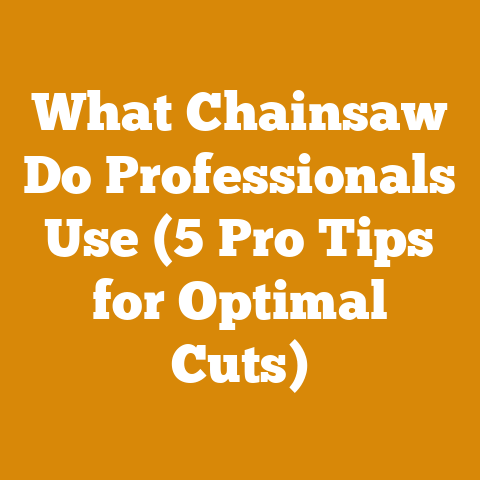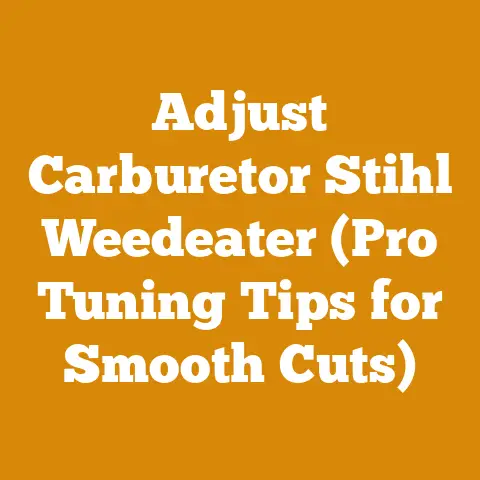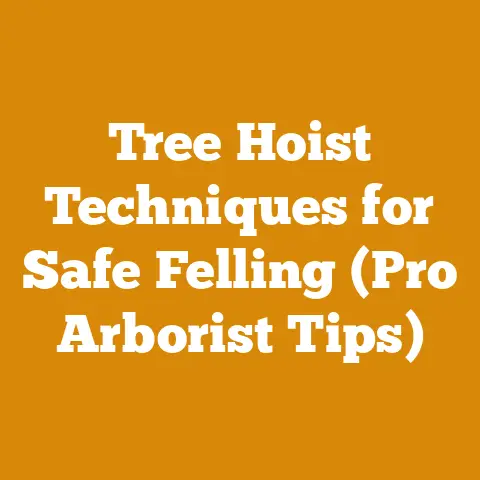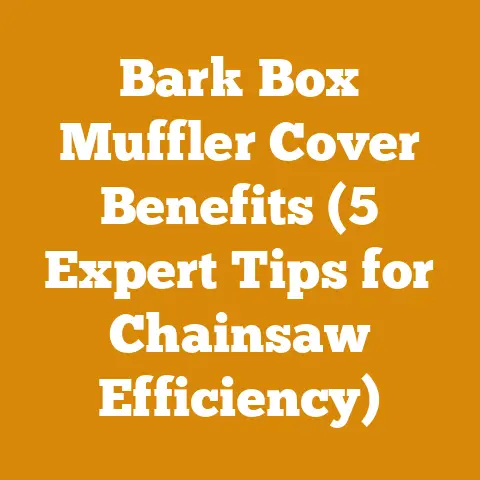Replacement Head Weed Trimmer for Tough Brush (Pro Tips Inside)
Let’s dive into the world of weed trimmer head replacements, specifically focusing on those designed to tackle tough brush. I’ll share my expertise, accumulated from years of battling thick undergrowth and stubborn weeds, to help you choose the right head and use it effectively. This guide will be your go-to resource for understanding the nuances of weed trimmer heads, from their types and selection to installation, maintenance, and advanced techniques.
Replacement Head Weed Trimmer for Tough Brush (Pro Tips Inside)
The realm of weed trimmers has been revolutionized by advancements in head technology. We’ve moved beyond simple string heads to robust, multi-blade systems capable of clearing dense brush with ease. These innovations have not only increased efficiency but also enhanced safety and reduced user fatigue. I remember the days of endlessly replacing string and struggling with thick vegetation. Now, with the right head, even the most challenging clearing tasks become manageable.
Understanding the Need for a Brush-Cutting Weed Trimmer Head
Standard string trimmer heads are great for light grass trimming. However, they quickly become ineffective when faced with thick weeds, small bushes, or dense brush. That’s where brush-cutting heads come in. These heads are designed to handle tougher materials and provide a more powerful cutting action.
- When to Upgrade: If you find yourself constantly replacing string, struggling to cut through thick vegetation, or experiencing frequent jams, it’s time to consider a brush-cutting head.
- Benefits: Brush-cutting heads offer increased power, durability, and efficiency compared to string heads. They can also reduce the risk of kickback and improve overall safety.
Types of Brush-Cutting Weed Trimmer Heads
The market offers a variety of brush-cutting heads, each with its own strengths and weaknesses. Understanding these differences is crucial for selecting the right head for your needs.
Metal Blade Heads
Metal blade heads are the workhorses of brush cutting. They feature one or more metal blades that rotate at high speeds to slice through thick vegetation.
- Single-Blade Heads: These are simple and effective for general brush cutting. They are less prone to clogging and offer good visibility.
- Multi-Blade Heads: Multi-blade heads provide more aggressive cutting action and are ideal for dense brush and small saplings.
- Brush Cutter Blades: These typically feature 2-4 thicker blades and are specifically designed for cutting through brush and small trees.
String Heads with Heavy-Duty String
While not as powerful as metal blades, string heads with heavy-duty string can handle moderately thick vegetation.
- Pros: String heads are generally safer to use around obstacles and are less likely to cause damage. They are also easier to replace and maintain.
- Cons: String heads are less effective on very thick brush and can wear out quickly.
Chain Heads
Chain heads utilize short lengths of chain that flail out to cut vegetation.
- Pros: Chain heads are very aggressive and can handle tough brush and small trees.
- Cons: Chain heads can be dangerous if not used properly. They are prone to kickback and can throw debris.
Factors to Consider When Choosing a Brush-Cutting Head
Selecting the right brush-cutting head depends on several factors, including the type of vegetation you’ll be cutting, the size of your trimmer, and your personal preferences.
Trimmer Compatibility
Ensure that the brush-cutting head is compatible with your trimmer model. Check the manufacturer’s specifications for recommended head types and sizes.
- Arbor Size: The arbor size of the head must match the arbor size of your trimmer.
- Power Requirements: Some brush-cutting heads require more power than others. Make sure your trimmer has enough power to operate the head effectively.
Type of Vegetation
Consider the type of vegetation you’ll be cutting most often.
- Light Brush: For light brush and weeds, a string head with heavy-duty string or a single-blade metal head may be sufficient.
- Dense Brush: For dense brush and small saplings, a multi-blade metal head or a chain head is recommended.
Safety Considerations
Safety should always be a top priority when using a brush-cutting weed trimmer.
- Protective Gear: Always wear appropriate protective gear, including eye protection, hearing protection, gloves, and sturdy footwear.
- Kickback: Be aware of the risk of kickback, especially when using metal blade heads or chain heads.
- Debris: Brush-cutting heads can throw debris at high speeds. Clear the area of people and pets before using the trimmer.
Ease of Use and Maintenance
Consider how easy the brush-cutting head is to install, use, and maintain.
- Installation: Some heads are easier to install than others. Look for heads that come with clear instructions and all necessary hardware.
- Maintenance: Metal blade heads require occasional sharpening. String heads require string replacement. Chain heads require chain lubrication.
Top Brush-Cutting Weed Trimmer Head Recommendations
Based on my experience and research, here are some of the top brush-cutting weed trimmer heads on the market:
- Oregon 55-265 Brush Cutter Blade: A durable and versatile blade for cutting through thick brush and small trees.
- Maxpower 333750B Metal Brush Cutter Blade: A cost-effective option for general brush cutting.
- Stihl Brush Knife Blade: A high-quality blade designed for Stihl trimmers.
- Arnold Polycut Head: A versatile head that can be used with both string and blades.
Step-by-Step Guide to Replacing Your Weed Trimmer Head
Replacing a weed trimmer head is a straightforward process, but it’s important to follow the steps carefully to ensure proper installation and safe operation.
Tools You’ll Need
- Wrench or socket set
- Screwdriver
- Gloves
- Eye protection
- New brush-cutting head
- Locking tool (usually a pin or screwdriver)
Step 1: Disconnect the Spark Plug Wire
Before starting any maintenance on your weed trimmer, disconnect the spark plug wire to prevent accidental starting.
Step 2: Lock the Trimmer Shaft
Most weed trimmers have a locking mechanism that prevents the shaft from rotating while you remove the head. This is usually a pin or a screwdriver that you insert into a hole in the trimmer head.
Step 3: Remove the Old Head
Use a wrench or socket set to loosen the nut or bolt that holds the old head in place. The direction to loosen the nut depends on the trimmer model. Some trimmers have a reverse-threaded nut, so you’ll need to turn it clockwise to loosen it.
Step 4: Install the New Head
Align the new head with the trimmer shaft and tighten the nut or bolt securely. Make sure the head is properly seated and that the blades or string are facing in the correct direction.
Step 5: Remove the Locking Tool
Remove the locking tool from the trimmer shaft.
Step 6: Reconnect the Spark Plug Wire
Reconnect the spark plug wire to the spark plug.
Step 7: Test the Trimmer
Start the trimmer and test the new head to make sure it’s working properly.
Safety Precautions When Using a Brush-Cutting Weed Trimmer
Using a brush-cutting weed trimmer can be dangerous if you don’t take the necessary precautions.
Wear Protective Gear
Always wear appropriate protective gear, including eye protection, hearing protection, gloves, and sturdy footwear.
- Eye Protection: Safety glasses or a face shield are essential to protect your eyes from flying debris.
- Hearing Protection: Earplugs or earmuffs can help protect your hearing from the loud noise of the trimmer.
- Gloves: Gloves can protect your hands from cuts and abrasions.
- Sturdy Footwear: Wear sturdy boots or shoes to protect your feet from injury.
Clear the Area
Before using the trimmer, clear the area of people, pets, and obstacles.
- People and Pets: Keep people and pets at least 50 feet away from the trimmer while it’s in use.
- Obstacles: Remove any rocks, branches, or other obstacles that could be thrown by the trimmer.
Use Proper Technique
Use proper technique to avoid injury and damage to the trimmer.
- Stance: Maintain a stable stance and keep your feet firmly planted on the ground.
- Grip: Grip the trimmer firmly with both hands.
- Cutting Angle: Use a shallow cutting angle to avoid kickback.
- Avoid Overreaching: Don’t overreach or extend yourself too far.
Inspect the Trimmer Regularly
Inspect the trimmer regularly for any signs of damage or wear.
- Blades: Check the blades for cracks, chips, or dullness. Replace the blades if necessary.
- String: Check the string for wear and tear. Replace the string if necessary.
- Guards: Make sure the guards are in place and in good condition.
- Nuts and Bolts: Check the nuts and bolts for tightness. Tighten them if necessary.
Maintenance Tips for Extending the Life of Your Brush-Cutting Head
Proper maintenance can significantly extend the life of your brush-cutting head and ensure optimal performance.
Clean the Head Regularly
Clean the head regularly to remove debris and prevent clogging.
- Metal Blade Heads: Use a wire brush to clean the blades.
- String Heads: Remove any tangled string or debris from the head.
- Chain Heads: Clean the chain with a solvent and lubricate it with oil.
Sharpen the Blades
Sharpen the blades regularly to maintain their cutting efficiency.
- Filing: Use a file to sharpen the blades at the correct angle.
- Grinding: Use a grinder to sharpen the blades if they are heavily damaged.
Replace Worn Parts
Replace worn parts as needed to prevent further damage and maintain performance.
- Blades: Replace the blades when they become dull or damaged.
- String: Replace the string when it becomes worn or broken.
- Nuts and Bolts: Replace any nuts or bolts that are stripped or damaged.
Lubricate Moving Parts
Lubricate moving parts regularly to reduce friction and prevent wear.
- Chain Heads: Lubricate the chain with oil to keep it running smoothly.
- Bearings: Lubricate the bearings in the head to prevent them from seizing.
Advanced Techniques for Cutting Tough Brush
Once you’ve mastered the basics of using a brush-cutting weed trimmer, you can move on to more advanced techniques for tackling tough brush.
Cutting at Different Angles
Experiment with cutting at different angles to find the most effective approach for different types of vegetation.
- Horizontal Cutting: Use a horizontal cutting motion for clearing large areas of brush.
- Vertical Cutting: Use a vertical cutting motion for trimming along fences and walls.
- Angled Cutting: Use an angled cutting motion for shaping bushes and shrubs.
Using a Pivot Technique
Use a pivot technique to cut through thick brush and small trees.
- Pivot Point: Select a pivot point near the base of the vegetation.
- Cutting Motion: Use a sweeping motion to cut through the vegetation, pivoting around the pivot point.
Working in Sections
Work in sections to avoid getting overwhelmed by large areas of brush.
- Divide the Area: Divide the area into smaller sections.
- Clear Each Section: Clear each section one at a time.
Using a Spotting Technique
Use a spotting technique to target specific weeds or brush.
- Identify the Target: Identify the target weed or brush.
- Approach Carefully: Approach the target carefully.
- Cut Precisely: Cut the target precisely.
Troubleshooting Common Problems with Brush-Cutting Weed Trimmers
Even with proper maintenance and technique, you may encounter problems with your brush-cutting weed trimmer. Here are some common problems and their solutions:
Trimmer Won’t Start
- Cause: Spark plug is fouled, fuel is stale, or air filter is clogged.
- Solution: Clean or replace the spark plug, replace the fuel, or clean the air filter.
Trimmer Runs Poorly
- Cause: Carburetor is dirty, fuel lines are clogged, or exhaust port is blocked.
- Solution: Clean the carburetor, clean the fuel lines, or clean the exhaust port.
Trimmer Head Won’t Rotate
- Cause: Drive shaft is broken, clutch is worn, or head is jammed.
- Solution: Replace the drive shaft, replace the clutch, or clear the jam.
Trimmer Head Vibrates Excessively
- Cause: Blades are unbalanced, head is loose, or bearings are worn.
- Solution: Balance the blades, tighten the head, or replace the bearings.
Case Studies: Real-World Applications of Brush-Cutting Weed Trimmers
To illustrate the effectiveness of brush-cutting weed trimmers, here are a few case studies based on my personal experiences and observations:
Clearing Overgrown Fence Lines
I once had a client with a fence line that was completely overgrown with weeds and brush. Using a brush-cutting weed trimmer with a metal blade head, I was able to clear the entire fence line in a matter of hours. The client was amazed at the transformation and the improved appearance of their property.
Reclaiming Abandoned Land
I’ve also used brush-cutting weed trimmers to reclaim abandoned land that was covered in thick brush and small trees. By systematically clearing the vegetation, I was able to restore the land to a usable condition.
Maintaining Trails and Paths
Brush-cutting weed trimmers are also ideal for maintaining trails and paths. They can quickly and easily clear overgrown vegetation, making the trails and paths safe and accessible.
The Future of Brush-Cutting Weed Trimmer Technology
The future of brush-cutting weed trimmer technology is likely to involve further advancements in blade design, motor technology, and safety features.
- Advanced Blade Materials: Expect to see blades made from even stronger and more durable materials, such as titanium and carbon fiber.
- Brushless Motors: Brushless motors are becoming increasingly popular due to their efficiency and long lifespan.
- Smart Technology: Smart technology, such as GPS and obstacle detection, could be integrated into brush-cutting weed trimmers to improve safety and efficiency.
Conclusion: Mastering the Art of Brush Cutting
Choosing the right replacement head for your weed trimmer is crucial for tackling tough brush effectively. By understanding the different types of heads, considering the factors that influence your choice, and following the safety precautions, you can master the art of brush cutting and keep your property looking its best. Remember to maintain your equipment regularly and use proper techniques to avoid injury and damage. With the right tools and knowledge, you can conquer even the most challenging brush-clearing tasks.
Next Steps:
- Assess your needs: Determine the type of vegetation you’ll be cutting most often.
- Research your options: Explore the different types of brush-cutting heads available.
- Choose the right head: Select a head that is compatible with your trimmer and suitable for your needs.
- Install the head: Follow the instructions carefully to install the head properly.
- Practice safe operation: Always wear protective gear and use proper techniques.
By following these steps, you’ll be well on your way to becoming a brush-cutting pro!






